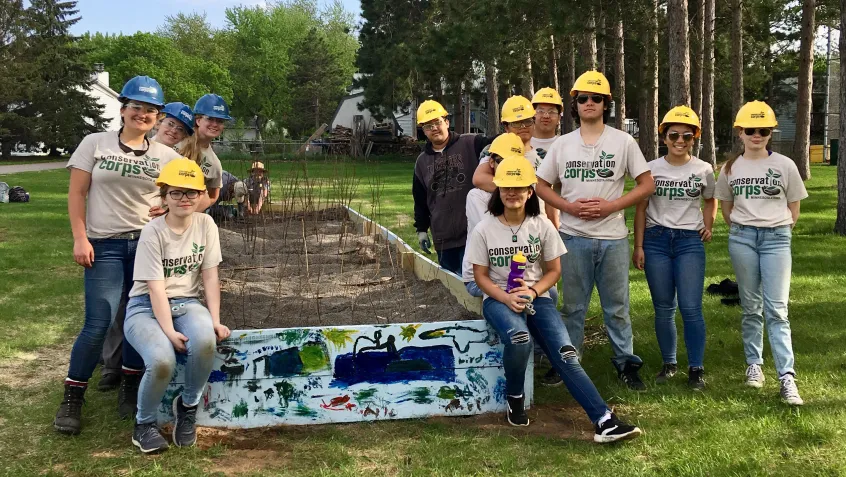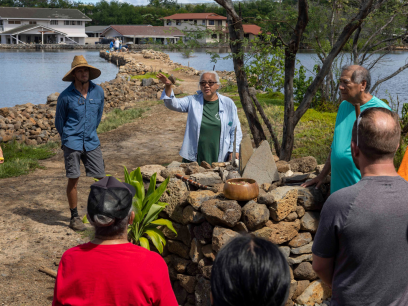
In the face of a changing climate, news of the disappearance of plant and animal species has become all too familiar—but have you ever heard of islands disappearing?
The Mississippi River used to hold thousands of islands along its 2,350-mile run, providing a necessary environment for birds, mammals, and aquatic animals that rely on them for habitat, breeding grounds, and shelter. Humans also directly benefited from the presence of these islands in the stream—by helping to slow the speed of the surrounding water, river islands reduce the amount of sediment that gets washed downstream, improving overall water quality.
However, the advent of year-round inland shipping—as well as an increasing number of record-breaking floods—has taken a toll on the Mississippi River’s ecosystem.
“The river has had so much additional flooding over the last several years compared to the past,” said Anna Waugh, development and communications manager with Mississippi Park Connection (MPC), a St. Paul, Minnesota nonprofit. “So we're seeing higher floods, and [ones] that last a lot longer. That means the islands are all eroding, and sediment is washing downstream.”
Today, the few islands that remain have become even more important to the health of the river and the animals that live there. In the face of increased flooding, the only way these islands can stand up to the current’s eroding power is with help from the roots of healthy vegetation, particularly trees.
Addressing a Lack of Local Biodiversity
At the Mississippi National River and Recreation Area, a 72-mile national park in Minnesota near the northern end of the mighty river, island tree populations support migratory birds and form the basis of great blue heron rookeries. Stands of cottonwood trees along the streambanks and on larger islands such as Settlers Island are also primary nesting sites for bald eagles.
In addition to serving as patriotic real estate, the mighty cottonwood is a major player on the floodplain: a mature tree can hold around 500 gallons of water at a time, an important skill for managing floodwaters, particularly as the climate shifts towards increased incidents of extreme precipitation and flooding.
Despite the rich diversity of wildlife supported by the river, much of the foundational foliage in and along the water has historically been homogenous. First elm, and then ash and cottonwood trees served to help hold the islands and riverbanks in place, but pressures including disease, predation, and pestilence—most notably from Dutch elm disease and emerald ash borers—laid waste to entire generations of these trees, leaving the riverine environments vulnerable to flooding.
“We took a survey, and one of the key findings was that we didn’t have any cottonwood trees that were smaller than 13 centimeters. And that meant we had a huge gap in succession,” said Mary Hammes, MPC’s environmental stewardship and volunteer manager. “If there aren't any young trees, it would be like if we didn't have any teenage humans. It was really concerning, and we knew this was a place where we could step in and help address this gap in succession.”
With funding from the National Environmental Education Foundation (NEEF)’s 2018 Every Day Event Grant, Mississippi Park Connection stepped in to help bridge these gaps and prepare the park for the future. Their approach focused on increasing the river’s biodiversity by replacing cottonwood and elm trees with a mixture of species better suited to the unpredictability of a changing climate. While that may sound daunting in and of itself, the trickiest task would be wrangling the sheer number of partners involved to make this vision a reality.
Growing Roots in the Mississippi River Community
The Mississippi National River and Recreation Area is unusual among National Park Service (NPS) units in that most of the land within the park borders doesn’t actually belong to the Park Service—in fact, of the site’s 54,000 acres, NPS owns less than 100. This can be traced back to the park’s relatively recent inception in 1988; by that time, most of the land already belonged to state and local government agencies such as the city of St. Paul, the county of Ramsey, and the City of Cottage Grove.
The main objective of the Mississippi Park Connection is to connect these various groups with each other and provide them with the tools they need to adequately care for the river.
“We like to call it the ‘kitchen sink’ of partnerships,” said Hammes. “There are so many partners, and our role is to make sure that we're knitting all of these interests together. It starts with just letting everyone know what's going on and making people feel included.”
To address the threatened river island canopy, MPC looked to build resilience in established ecological systems through a series of planned volunteer projects aimed at diversifying the types of trees in and around the river. Building on expert knowledge provided by the University of Minnesota, the group selected several species expected to perform well under future climate conditions, when winter lows are warmer and extreme precipitation events are expected to be more frequent.
Having procured the young trees, the next step involved starting them in gravel beds. This helps the saplings build fibrous root tissue, increasing their chances of survival once planted on Settlers Island.
“The way [this process] works is we put the trees in the nursery in the spring and then heavily irrigate the root systems,” said Waugh. “Then the roots become very robust—much more so than if we were to purchase them from a commercial nursery and put them directly into the ground.” Waugh said the trees were “three times more likely to live” when grown using this nursery process.
On May 16, the new gravel bed for the saplings was built in partnership with the National Park Service, the City of Cottage Grove, and the youth outdoors crew of the Conservation Corps. Afterwards, students from Pine Hill Elementary School helped to decorate the beds with paintings of river scenes that held special meaning to them.
The youth Conservation Corps team—a group of 15- to 18-year-old high school students who come from 80% or below the median area income level—worked with MPC’s AmeriCorps staffer to lay irrigation lines in the bed and advise the elementary school students as they planted the young Kentucky coffeetree, hackberry, and American sycamore saplings.
“The philosophy behind our volunteer program is that when you are working outside and with a group of people towards a common good, you grow in your sense of self confidence and in your sense of belonging to the group,” said Hammes. “We see that as a real gift we can give our community.”
Battling Buckthorn and Other Invasive Species
Before these young trees could be planted in their forever home on Settlers Island, the area first needed to be cleared of invasive species that could harm their development. For the past few years, the Friends of the Mississippi River (FMR), a local conservation group, has worked to clear the island of buckthorn, a shrub-like invasive plant that “shades out” native species and can be quite tricky to get rid of. Crews would need to make one final push to clear the island of buckthorn to ensure the new plants had the space and sunlight they needed to survive.
"This project really wouldn't have happened without [FMR's] partnership," said Waugh. "Their project plan, ecologists, and on-the-ground support ensured that we were actually making a difference."
During an MPC-led event in late August, volunteers managed to fill four bags of trash and clear over three acres of buckthorn from the island. They also left with newfound knowledge about this invasive plant—which was used as a popular shrub for marking property boundaries through the late 1990s—including the damage it can cause to local ecosystems and how to identify and remove it from their houses and yards.
Rebuilding an Island Oasis
In honor of National Public Lands Day, MPC's final event of the year involved transplanting the now-established young trees from their gravel bed nursery to their new home on Settlers Island. These tiny saplings had spent the whole summer irrigating and establishing robust root tissue, and were now ready to help anchor the sandy island against the relentless waters of the Mississippi. On September 26, with the river cooperating—for the moment, at least—volunteers were able to transport and plant 450 trees on the island.
“At one point I walked through the woods and saw people everywhere planting and touching the earth and engaging with nature and the forest,” said Waugh. “And the scale of that many people working together on a common project outside was striking. I think we don't really see that kind of effort in our day-to-day lives.”
Though the hard part may be over, care for these important trees is never truly done. Conservation Corps members will continue to monitor, water, and maintain the trees for up to three years to ensure they survive and thrive on the island.
As they mature, these native trees will play an important role in the survival of the river’s ecosystem. They will support native species of birds as a habitat and breeding area far from human pressures on shore. They will help hold the river island together, reducing the rate of erosion and improving overall water quality. They will slow the surrounding waters, creating eddies in the river that provide a habitat for native fish species. And they will provide an attractive point of interest along a water trail for Cottage Grove, helping to support local recreation and tourism.


